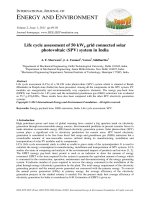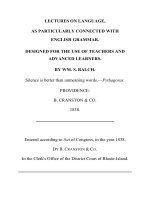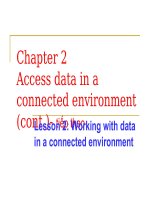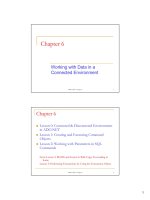connected filters
Bạn đang xem bản rút gọn của tài liệu. Xem và tải ngay bản đầy đủ của tài liệu tại đây (11.77 MB, 74 trang )
Connected Filters
Michael H. F. Wilkinson
Institute for Mathematics and Computing Science
University of Groningen
The Netherlands
SSIP, Vienna, July 11, 2008
Vienna, 1899
SSIP, Vienna, July 11, 2008 1 of 73
Outline
Filters by Reconstruction
Attribute filters
Max-trees:
Data structure
Use in attribute filtering
Shape filters and distributions
Computing multi-variate pattern spectra
Adapting the Max-tree:
Iso-surface browsing
Splatting
Parallel computation
Other work
SSIP, Vienna, July 11, 2008 2 of 73
An Example
Lenna with noise (left) structural open-close with square S.E. (middle) area
open-close (right)
SSIP, Vienna, July 11, 2008 3 of 73
Definitions I
Let E be some universal set and P(E) the set of all subsets of E.
For a binary image X ⊆ E a connected foreground component C is a connected
subset of X of maximal extent.
If C is a connected foreground component of X we denote this as C X.
A connected backround comp onent of X is a connected foreground component of
the complement X
c
of X.
A partition of E is a set A ⊂ P(E) of sets α
i
for which
i
α
i
= E, and (1)
i = j ⇒ α
i
∩ α
j
= ∅. (2)
The set A
X
of all connected foreground and background components of X form a
partition of E.
SSIP, Vienna, July 11, 2008 4 of 73
Definitions II
Let A = {α
i
} and B = {β
j
} be partitions.
A is said to be finer than B iff for every α
i
there exists a β
j
such that α
i
⊆ β
j
.
If A is finer than B then B is coarser than A.
Let Ψ : P(E) → P(E) be a binary image operator, and A
Ψ(X)
be the partition of
E consisting of all foreground and background components of Ψ(X).
Ψ is a binary connected operator if for any image X the partition A
X
is finer
than A
Ψ(X)
.
The connected opening Γ
x
is defined as
Γ
x
(X) =
C : C X ∧ x ∈ C if x ∈ X
∅ otherwise.
(3)
SSIP, Vienna, July 11, 2008 5 of 73
Reconstruction
original f marker g = γ
21
f reconstruction of f by g
The edge preserving effect of openings-by-reconstruction compared to structural
openings
SSIP, Vienna, July 11, 2008 6 of 73
Reconstruction
The basis of an opening by reconstruction is the reconstruction of image f from
an arbitrary marker g.
This is usually defined using geodesic dilations
¯
δ
f
defined as
δ
1
f
(g) = f ∧ δ(g). (4)
This operator is used iteratively until stability, to perform the reconstruction ρ i.e.
ρ(f|g) = lim
n→∞
¯
δ
n
f
g =
¯
δ
1
f
. . .
¯
δ
1
f
¯
δ
1
f
until stability
(g). (5)
In practice we apply
¯
δ
n
f
with n the smallest integer such that
¯
δ
n
f
g =
¯
δ
n−1
f
g. (6)
SSIP, Vienna, July 11, 2008 7 of 73
Openings-by-Reconstruction
What this process does in the binary case is reconstruct any connected component
in f which intersects some part of g.
An opening-by-reconstruction ¯γ
X
with structuring element (S.E) X is computed
as
¯γ
X
(f) = ρ(f|γ
X
(f)), (7)
in which γ
X
denotes an opening of f by X.
Reconstructing from this marker preserves any connected component in which X
fits at at least one position.
Closing-by-reconstruction
¯
φ
X
can be defined by duality, i.e.
¯
φ
X
(f) = −¯γ
X
(−f) (8)
SSIP, Vienna, July 11, 2008 8 of 73
Structural Openings vs. Reconstruction
X X ◦ B ρ(X|X ◦ B)
The structural opening X ◦ B, with B a 7 × 7 square, yields the union of all 7 × 7
squares which fit into X. Clearly this distorts the connected components and is
not a connected filter.
The opening-by-reconstruction ρ(X|X ◦ B) preserves all connected components
of X into which at least one 7 × 7 square fits. This can be considered an attribute
filter.
SSIP, Vienna, July 11, 2008 9 of 73
Levelings
Openings-by-reconstructions are anti-extensive, and closings-by-reconstructions
are extensive, removing bright or dark image details respectively.
Meyer (J.Math. Imag. Vis. 2004) proposed levelings as an auto-dual extension of
reconstruction filters.
In this case a marker is used which may lie partly above and partly below the
image.
We can compute a leveling of λ(f|g) of f from marker g as
(λ(f|g))(x) =
(ρ(f|g))(x) if f(x) ≥ g(x)
−(ρ(−f| − g))(x) if f(x) < g(x),
(9)
Levelings allow edge-preserving simplification of images, by simultaneously
removing bright and dark details.
SSIP, Vienna, July 11, 2008 10 of 73
Example: Levelings
original blurred by Gaussian leveling
Leveling using a Gaussian filter to simplify the image in an auto-dual manner.
SSIP, Vienna, July 11, 2008 11 of 73
Example: Leveling Cartoons
original cartoon texture channel
Leveling cartoons for texture/cartoon decomposition.
SSIP, Vienna, July 11, 2008 12 of 73
Attribute Filters I
Introduced by Breen and Jones in 1996.
Examples: area openings/closings, attribute openings, shape filters
How do they work?
Binary image :
1. compute attribute for each connected component
2. keep components of which attribute value exceeds some threshold λ
SSIP, Vienna, July 11, 2008 13 of 73
Attribute Openings: Formally
Let T : P(E) → {false, true} be an increasing criterion, i.e. C ⊆ D implies that
T (C) ⇒ T(D).
A binary trivial opening Γ
T
: P(E) → P(E) using T as defined above is defined
as
Γ
T
(C) =
C if T (C),
∅ otherwise.
(10)
A typical form of T is
T (C) = (µ(C) ≥ λ) (11)
in which µ is some increasing scalar attribute value (i.e.
C ⊆ D ⇒ µ(C) ≤ µ(D)), and λ is the attribute threshold.
The binary attribute opening Γ
T
is defined as
Γ
T
(X) =
x∈X
Γ
T
(Γ
x
(X)), (12)
in other words it is the union of all connected foreground components of X which
meet the criterion T .
SSIP, Vienna, July 11, 2008 14 of 73
Attribute Openings: Examples
X T = A(C) ≥ 11
2
T = I(C) ≥ 11
4
/6
An area opening is obtained if the criterion T = A(C) ≥ λ, with A the area of
the connected set C.
A moment-of-inertia opening is obtained if the criterium is of the form
T = I(C) ≥ λ, with I the mome nt of inertia.
SSIP, Vienna, July 11, 2008 15 of 73
Other Attribute Filters
If criterion T is non-increasing in (10), Γ
T
becomes a trivial thinning, or trivial,
anti-extensive grain filter Φ
T
:
Φ
T
(C) =
C if T (C),
∅ otherwise.
(13)
Using a trivial thinning rather than a trivial opening in (12), Γ
T
becomes an
attribute thinning or anti-extensive grain filter Φ
T
:
Φ
T
(X) =
x∈X
Φ
T
(Γ
x
(X)), (14)
The extensive dual of the atribute opening Γ
T
is the attribute closing Ψ
T
, which
is defined as
Ψ
T
(X) = (Γ
T
(X
c
))
c
. (15)
The extensive dual of the attribute thinning is the attribute thickening, which is
defined as above, but with a non-increasing criterion.
SSIP, Vienna, July 11, 2008 16 of 73
Non-Increasing Attributes
Attribute thinnings can be defined using the usual form T (C) = (µ(C) ≥ λ) if µ
is non-increasing, e.g.:
Perimeter length P
Circularity (or boundary complexity) P
2
/A
Concavity: (H − A)/A, with H the convex hull area
Elongation (non-compactness): I/A
2
Any of Hu’s moment invariants
Alternatively, increasing attributes (i.e. C ⊆ D ⇒ µ(C) ≤ µ(D)) can be used if
the form of T is changed:
T = (µ(C) = λ)
T = (µ(C) ≤ λ)
etc.
SSIP, Vienna, July 11, 2008 17 of 73
The Grey-scale Case
In the case of attribute openings, generalization to grey scale is achieved through
threshold decomposition.
A threshold set X
h
of grey level image (function) f is defined as
X
h
(f) = {x ∈ E|f(x) ≥ h}. (16)
The grey scale attribute opening γ
T
based on binary counterpart Γ
T
is given by
(γ
T
(f))(x) = sup{h ≤ f(x)|x ∈ Γ
T
(X
h
(f))} (17)
Closings ψ
T
are defined by duality:
ψ
T
(f) = −γ
T
(−f). (18)
The non-increasing case will be dealt with after discussing the algorithms.
SSIP, Vienna, July 11, 2008 18 of 73
(Semi) Auto-dual filtering
A filter is auto-dual (or self-dual) if it is invariant to inversion:
ψ(f) = −ψ(−f) (19)
An approximation is offered by alternating sequential filters (ASFs), which consist
of an alternating sequence of openings and closings of increasing scale (e.g. radius
of structuring element).
Let γ
a
λ
be a area opening of attribute threshold λ, and φ
a
λ
the corresponding area
closing.
The area N-Sieve ψ
N
λ
is given by
ψ
N
λ
(f) = φ
a
λ
(γ
a
λ
(. . . (φ
a
2
(γ
a
2
(φ
a
1
(γ
a
1
(f))))) . . .)) (20)
and is an alternating sequential filter.
The corresponding M-Sieve ψ
M
λ
is just
ψ
M
λ
(f) = γ
a
λ
(φ
a
λ
(. . . (γ
a
2
(φ
a
2
(γ
a
1
(φ
a
1
(f))))) . . .)) (21)
SSIP, Vienna, July 11, 2008 19 of 73
Grey Scale Example
f γ
a
256
(f)
φ
a
256
(f) ψ
N
256
(f)
SSIP, Vienna, July 11, 2008 20 of 73
Definitions for Grey Scale
A level set L
h
of image f is defined as
L
h
(f) = {x ∈ E|f(x) = h} (22)
A flat zone or level component L
h
at level h of a grey scale image f is a
connected component of the level set L
h
(f).
peak component P
h
at level h is a connected component of the thresholded set
X
h
(f).
A regional maximum M
h
at level h is a level component no members of which
have neighbors larger than h. A
At each level h there may be several such components, which will be indexed as
L
i
h
, P
j
h
and M
k
h
, respectively.
Any regional maximum M
k
h
is also a peak component, but the reverse is not true.
SSIP, Vienna, July 11, 2008 21 of 73
Definitions for Grey Scale
X
h"
X
h'
X
h
h
h'
h"
L
1
h"
M = P = L
1 1 1
h h h
P
1
h'
M = P = L
2 2 2
h h h
(a) (b)
One-dimensional example of level components, peak components and regional
maxima.
SSIP, Vienna, July 11, 2008 22 of 73
Algorithms for the Grey-scale Case
Naive computation of these filters in the grey-scale case can be done by threshold
decomposition. This is SLOW!
Three faster algorithms have been proposed
A priority-queue based approach (Vincent, 1993; Breen & Jones, 1996): low
memory cost, time complexity O(N
2
log N).
A union-find approach (Meijster & Wilkinson 2002): low memory cost, time
complexity O(N log N), fastest in practice, only for increasing filters.
The Max-tree based approach (Salembier et al., 1998): high memory cost, tim e
complexity O(N), most flexible.
The Max-tree method was combined with the union-find method by Najman
and Couprie (2003), and extended floating point (Geraud et al. 2007).
A variant of the Max-tree for second-generation connectivity was developed
(Ouzounis and Wilkinson 2005, 2007)
A parallel variant has been developed recently (Wilkinson et al, 2008).
SSIP, Vienna, July 11, 2008 23 of 73
Priority-Queue Algorithm I
Create a list of all regional maxima M
k
h
.
Select a seed pixel p
k
h
from each maximum M
k
h
.
For each seed p
k
h
do
push p
k
h
in priority queue, with grey level as priority.
start flood-filling the peak component P
j
h
around the regional maximum
Stop if either
the flooded area is equal to λ, or
a pixel is retrieved from the priority queue with grey value h
> h
. In this
case the region grown so far is not a peak component P
j
h
at level h
.
Flood the region with grey value λ.
The algorithm terminates when all maxima have been processed.
SSIP, Vienna, July 11, 2008 24 of 73









